The sustainability of agriculture and food production starts with farmers. Through their decisions and management practices, they demonstrate continuous improvement toward sustainable goals, and these practices carry through the entire value chain.
Field to Market: The Alliance for Sustainable Agriculture is a checkoff-supported organization measuring sustainability progress through several social and environmental indicators. These markers include soil conservation, greenhouse gas emissions and the use of irrigation water, energy and land. The group recently released the third edition of its Field to Market National Indicators Report.
The report analyzes sustainability trends over the past 36 years for 10 crops, including soybeans, barley, corn (for grain and silage), cotton, peanuts, potatoes, rice, sugar beets and wheat. Its findings provide the tools to discuss sustainability priorities while creating a baseline against which to monitor and measure future change.
Key Learnings
Overall, the report shows improved environmental performance for all crops in nearly every key indicator.
- For soybeans, both total production and planted area have increased from 1980 to 2015. Yield gains have driven improvements in irrigation water use, energy use and greenhouse gas emissions on a per-bushel basis, and these indicators have increased slightly on a per-acre basis.
- Another notable takeaway from the report is how U.S. agriculture generates economic value. Commodity crop production has increased the generation of economic value over the period of 1997 to 2015, as measured by the contribution of agriculture to national gross domestic product.
- While the report demonstrates good progress, it also shows long-term improvements for several crops have plateaued within the past five to 10 years. This presents both a challenge and an opportunity for the industry to ensure continued improvements going forward.
“The entire food and agriculture value chain must work together,” says Rod Snyder, president of Field to Market. “Together, we can identify technology improvements to address sustainability outcomes, while promoting research on conservation practices and the necessary infrastructure, training and knowledge to increase adoption on farms across the country.”
This year’s report shows the overall expansion of the Field to Market program by including five additional crops. Environmental indicators used in the 2016 report build on the previous two reports as well as the Fieldprint® Calculator.
Helpful Tool
Fieldprint Calculator is a free, confidential online tool developed with input from grower organizations, agribusinesses, food companies, economists and conservation groups. Farmers can use this checkoff-supported tool to evaluate natural-resource use on their farms or ranches and see how they compare to state and national averages.
“Agriculture is increasingly turning its attention to how to improve sustainability,” says Snyder. “The Fieldprint Calculator provides the most convenient and all-inclusive way to look at overall sustainability on the farm, and helps farmers and the supply chain explore opportunities for continuous improvement.”
